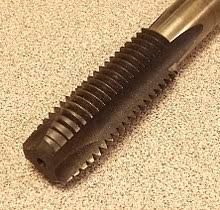Tapping is a crucial machining process used to create internal threads in a hole, allowing bolts and screws to fasten components together securely. Below are just some of the basics to give you an introduction to tapping.
Understanding Tapping
Tapping involves cutting threads inside a pre-drilled hole using a tool called a tap. The process ensures that the hole has the correct size and shape to accommodate a threaded fastener.
Types of Taps
There are several types of taps:
Bottoming Taps – According to Yamawa, these taps have minimal tapering, with only a slight chamfer at the tip. They are specifically used for threading the full depth of blind holes, completing threads that have already been partially formed.
Plug Taps – With a shorter tapered section, plug taps are designed to extend the threading deeper into the material, following the initial cut made by a taper tap.
Taper or Starter Taps – These taps feature a gradual taper along the initial 20-30% of their length, which helps them to engage threads slowly and centre themselves more accurately when beginning the threading process.
Using Tapping Machines
Tapping machines automate the process, ensuring precision and efficiency. These machines, such as the examples seen at https://www.cotswold-machinery-sales.co.uk/roscamat-tapping-machines/, offer various benefits:
Consistency – Tapping machines provide uniform threads, reducing the risk of human error.
Speed – They significantly speed up the tapping process, making them ideal for high-volume production.
Ease of Use – Modern tapping machines are user-friendly, often featuring adjustable settings for different thread sizes and pitches.
Best Practices for Tapping
To achieve the best results, follow these practices:
Correct Drill Size – Ensure the pre-drilled hole is the correct size for the tap being used. A hole that is too small can cause the tap to break, while a hole that is too large can result in weak threads.
Lubrication – Use appropriate tapping fluid to reduce friction and prevent tap breakage.
Steady Pressure – Apply consistent pressure when using hand taps to avoid uneven threads.
Cleanliness – Keep the hole and tap free of debris to ensure smooth operation.




